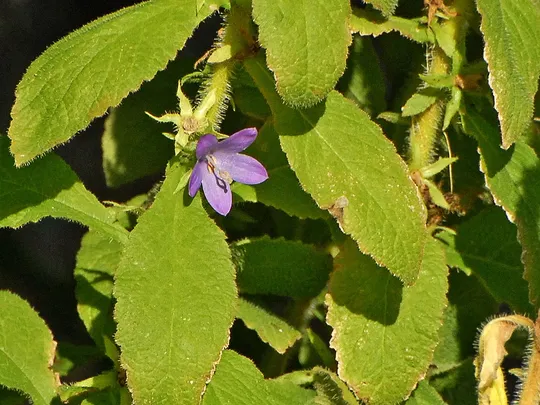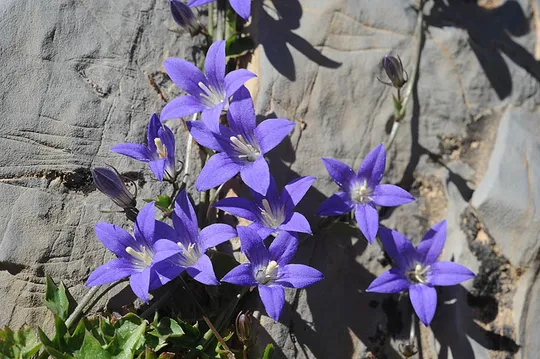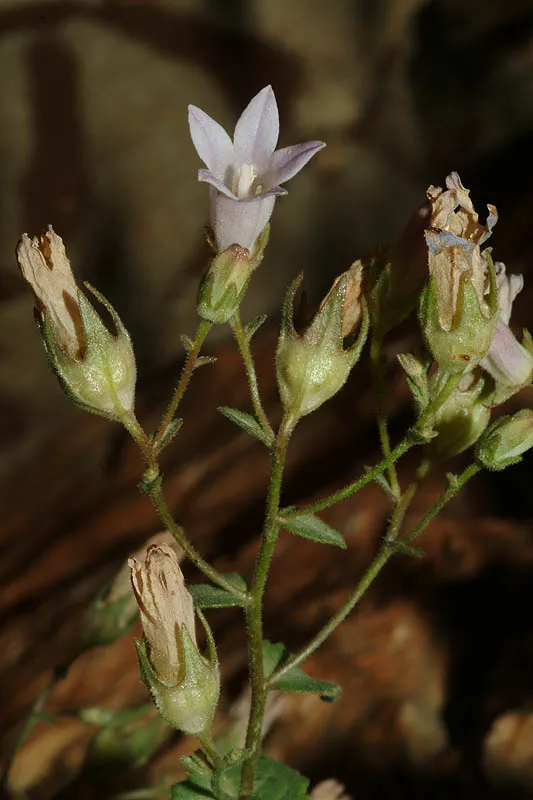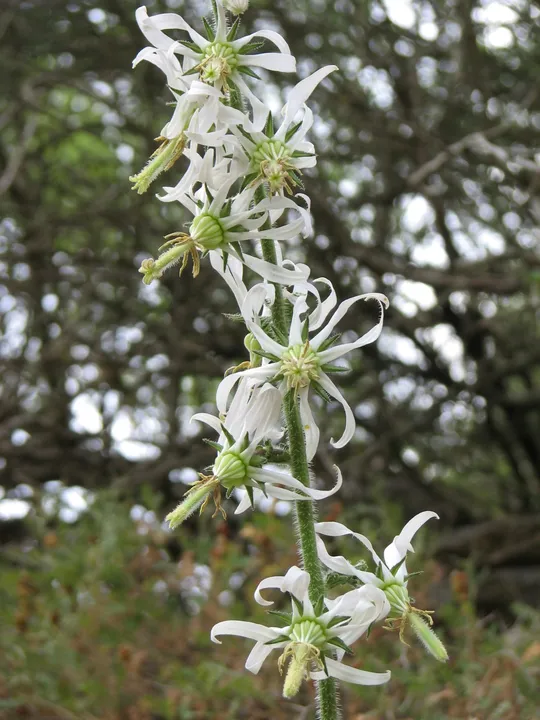Sidon Bellflower
Campanula sidoniensis
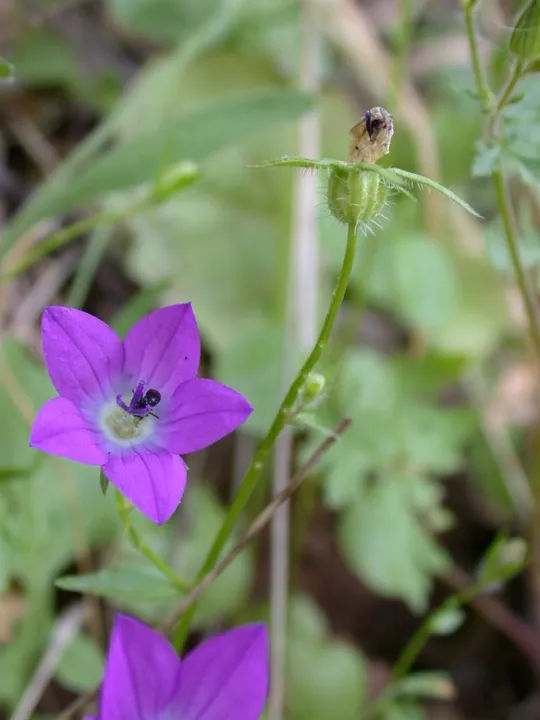
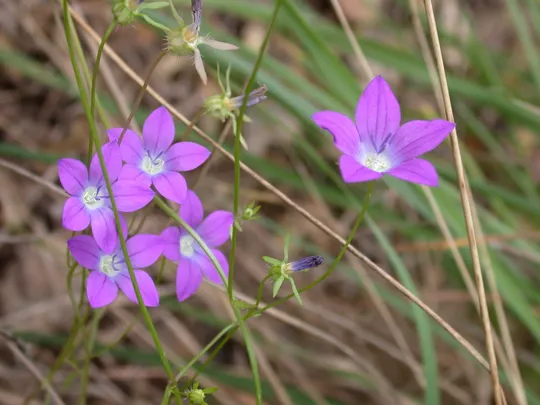
Campanula sidoniensis grows today
only in the Upper Galilee, on six documented sites with certainty (for decades): three sites in
the Kziv Stream section, one site in the Betset Stream, one in Wadi Sha'al and one
site in Wadi Kedesh in the eastern Upper Galilee. According to estimates there
are about 10 sites. The species was once found in the small canyon near Yiftah
in the Tarshiha area (Smoli, 1924), but is now extinct there. It was also collected
and seen in the Lower Galilee, where it was found for the first time in 1991 in
the Kfar HaHoresh forest as a new species for the region (Gavri Sion and Hagar
Lashner), but it was not found subsequently. C. sidoniensis
was discovered as new species for Israel between En Harod and Tel Yosef in 1924
at the bottom of the Gilboa (Jezreel Valley?), but is now extinct from there. The
species may also grow on Mount Hermon, in the western wadis (Wadi Hazuri, Wadi Govta)
within the Mediterranean woodland zone.
Damp rocks, shallow soil on slopes, stream banks in
partly or completely sunny sites, in moist Mediterranean woodland clearings
with precipitation over 500 mm.
For the genus – see Campanula peregrina. C. sidoniensis belongs to the Rapunculus section within the genus. The section has
many species, including perennial species such as C. rapunculus that is common in Israel and
delicate annual species, e.g. C. phrygia and C. retrorsa. The last two species are taxonomically
close to C. sidoniensis. The closest species to it is C. flaccidula,
a delicate annual species growing in limestone rock crevices and on moist shaded
rocks in Turkey, northern Iraq and western Iran. C. phrygia, which belongs to the same group, is annual
species that was observed and collected only three times in Israel and its identification
is not clear, nor whether its populations in Israel are permanent or episodic.
·
The number of regions in which Campanula sidoniensis grows is
considerably reduced compared to the past and the number of sites has decreased
as well.
·
C. sidoniensis has a localized
patchy spatial distribution pattern and grows in density magnitudes of about
100 plants to 1500 square meters. In Wadi Kedesh the distribution area is wider
and the number of individuals is greater. The species is renewed annually from
seeds from within the same patch, but there is not enough information regarding
seed fertility and germination rates. The patches are located in woodland
clearings with little soil, an uncommon habitat.
·
C. sidoniensis is moderately
vulnerable to damage: the likelihood of development on its growth sites is low
and the sites are far from settlements, but they are close to trails used by
hikers, for whom C. sidoniensis flowers might be
attractive for picking – they are visible but not very prominent.
·
C. sidoniensis sites in the western
Upper Galilee are located in the Kziv Stream and Betset Stream nature
reserves. The site at Wadi Kedesh in the
eastern Upper Galilee is located near the boundaries of the Wadi Kedesh Nature
Reserve, but outside them.
·
Its local threat status is equivalent to its global
threat status, since the species is endemic only to Israel and Lebanon.
All the Campanula sidoniensis populations on
all known sites in the Upper Galilee should be monitored. The Wadi Kedesh site should
be included in the nearby nature reserve. Seeds should be collected and
dispersed in a similar habitat near known sites and sites on which the species
is now extinct; it should also be grown in refuge gardens.
Campanula sidoniensis is endemic to
Israel and Lebanon. It is not known from western Syria or southern Turkey. The species
belongs to a group of endemic species whose range is in Lebanon and northern
Israel. In Lebanon, its main distribution area is west of the Lebanese Mountains,
in the Mediterranean region from Beirut southwards. Most of the sites are found
in the low Mediterranean zone, but it is occasionally found higher up as well:
up to an altitude of 1100 meters (Tibnin, Jezzine). Two unusual sites are found
in the high Lebanese Mountains southeast of Tripoli (Hadith el Joubbe – 1400
m).
Campanula sidoniensis is an annual
herb that grows only in the Upper Galilee on a small number of sites. It is endemic
to Israel and Lebanon. The number of regions and sites on which the plant is
found has decreased. Most of the sites where C. sidoniensis is found are
protected and its habitats are not vulnerable to development. The classification
of the plant as an endangered species worthy of conservation efforts reflects
its rarity, its endemism, the patchy spatial distribution patter of its
populations and the uniqueness of its habitat.
Current Occupancy Map
| 1000 squre meter pixel | 5000 squre meter pixel | 10000 squre meter pixel | |
|---|---|---|---|
| number of observations | 0 | 0 | 0 |
| in total pixels | 0 | 0 | 0 |
| Family | Campanulaceae |
| Classification | On the endangered species list |
| Ecosystem | Mediterranean |
| Chorotype | Eastern Mediterranean |
| Conservation Site | Wadi Kedesh |
| Rarity |
1
3
6
|
|---|---|
| Vulnerability |
0
0
4
|
| Attractiveness |
0
1
4
|
| Endemism |
0
2
4
|
| Red number |
1
3.7
10
|
| Peripherality | N |
| IUCN category | DD EW EX LC CR EN VU NT |
| Threat Definition according to the red book | Vulnerable |
 Based on:
Based on:
